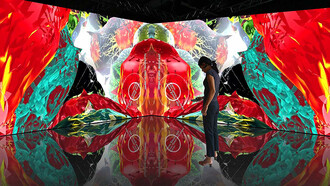The dominant art movements in the US in the 1960s and 70s were Pop, Conceptualism, Minimalism, maybe Fluxus. When you think of the most famous artists of this period, not many were women. So if you were a female American artist at this time, interested in your own humane development, open to the artistic influences of Asia through which you had traveled and learned, moved by what you had learned through Balanchine’s innovations to dance, and you created art as a way to better understand your possible growth as a person, oblivious to the trends on the Upper East Side of Manhattan, what were the odds your work would wind up at the Castelli Gallery? Zero, of course.
But this is the definition of real art and what a real artist is – someone who engages in a constant type of feedback process between human development and creation, where the art becomes meaningful to the artist who is growing and guides her growth while others can also benefit from this process of insight, growth and creation. Kandinsky, for example, believed this was what an artist was and did. If this is not what an artist is or should be, then we really do not need art. Frankly, there was a lot of art in the 60s and 70s we probably did not need but it was promoted by very sharp and greedy men and it wound up in our art museums because it was collected by the “right” people and written about in the “right” periodicals. There is a lot of art now being created that we probably don’t need. We don’t need soulless experimental formalism or self-referential art, but certain people like to buy it and when they die it goes into MoMA.
The Cynthia Polsky show which recently closed at Pearl Lam’s Hong Kong gallery is a rediscovery or reexamination of the large-scale paintings and works on paper from 1963 to 1974 done by American artist Cynthia Polsky, who was a woman in a male-dominated field and who chose to be inspired and work through techniques and colors she discovered in Asia and not which were chosen to appeal to the market by male art dealers in Manhattan wearing Italian suits and chomping on Cuban cigars. Polsky’s palette is influenced by the radiant colors we find in South Asian Rajput and Mughal art and not the colors found in comic books or advertisements. These Asian inspired colors often derived from minerals, plants, shells, and sometimes precious stones. Traces of lines or demarcations sometimes derived from the influence of Chinese ink paintings and Japanese calligraphy.
Balanchine added greater quickness to dance, greater flourishes, more style and expression. Polsky studied these techniques and we can see their influence in her work. We sense progress, fulfilment, subtle change and emergence in her larger paintings. She did not stumble around a canvas creating images to evoke anxiety, conflict or confusion. Her canvases convey rhythm, elegance, vitality, symmetry and style. Polsky, herself, referred to her work as lyrical expressionism.
According to the notes for the show, for her larger works, Polsky applied acrylic paint to unstretched canvas on the floor, with bulky objects in an irregular pattern underneath the canvas to create an uneven surface. She would work intuitively and quickly using sponges or Chinese ink brushes. Polsky would then hang the work up to allow the paint to drip downward on the canvas. These drips are what really drew me into her paintings. They represented a type of sudden and emergent dendritic branching or creation of a root system from the density of a specific color. The drips represented outreach and penetration with the background of dense or scarce dots of paint becoming a means of assessing or measuring the new quality.
Polsky’s work, to me, actually, is a logical continuation of the experiments in action art created by Jackson Pollock. I recall one art historian writing that many art critics believed a new humanism would appear in art after Pollock’s innovations and that many were shocked when Pop Art appeared instead. The market and gallery owners were, perhaps, more powerful than what should have or was expected to happen. Indeed, going from Abstract Expressionism to Pop Art was quite a bifurcation. Art was hijacked by gallery owners and buyers. A more humane art was not sought by the art-buying honchos; why would they want this? Art was steered forever toward the demands of the market place and away from the artist’s personal journey.
Polsky’s tweak of action art involved creating density or sparseness while also combining vibrant colors in seamless patterns toward a psychological effect in her viewers. She engaged in immediate mark-making from the inner to outer worlds, trusting in her intuition and perhaps chance operations to obviate the flaws and deficiencies of the human will while allowing a connection with the consciousness of the observer. I am not sure whether Polsky knew this, but chromotherapy was used as a healing process in ancient China. The color red, for example, increased blood circulation while blue was a soothing influence on the viewer. Polsky’s work, in her use of and combination of colors, and in her abstract depiction of a process of emergence, allays pain through the hope of a gentle progression toward a higher and more humane state of being.















